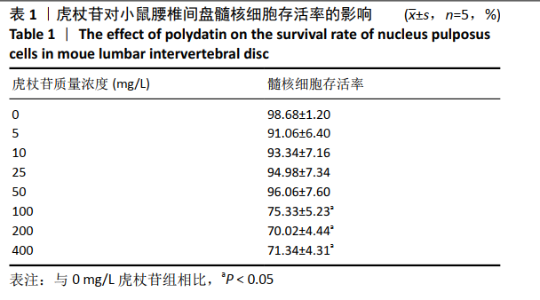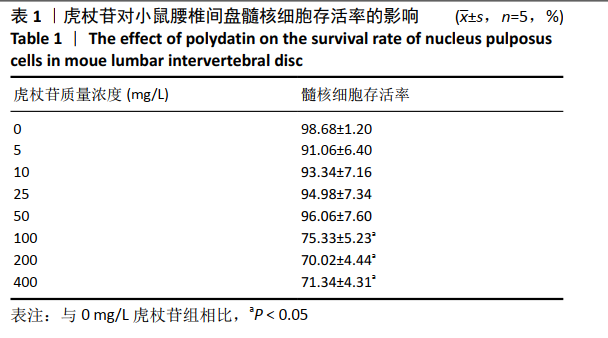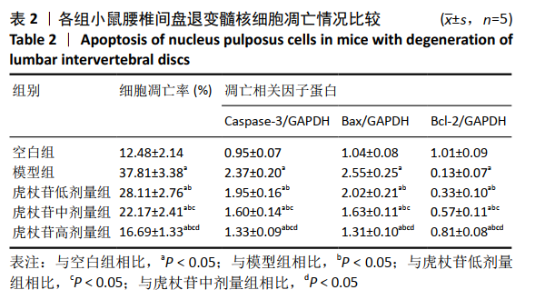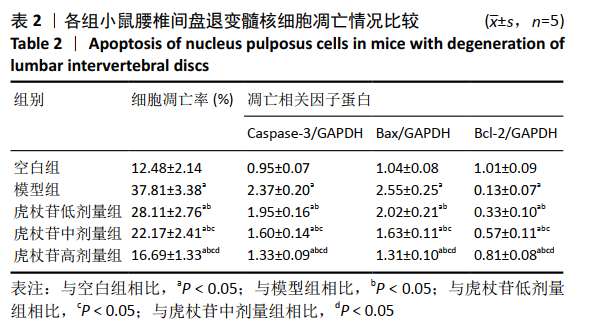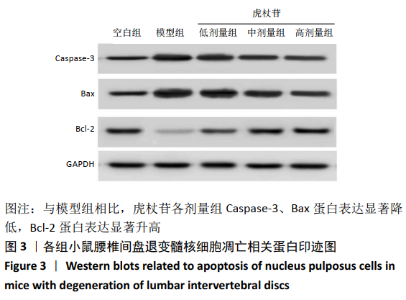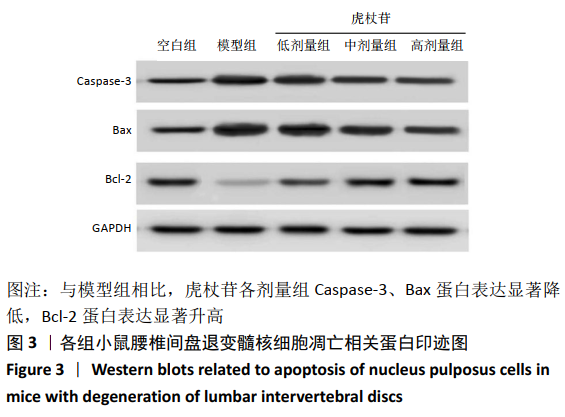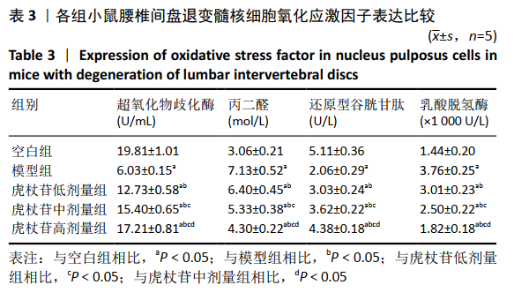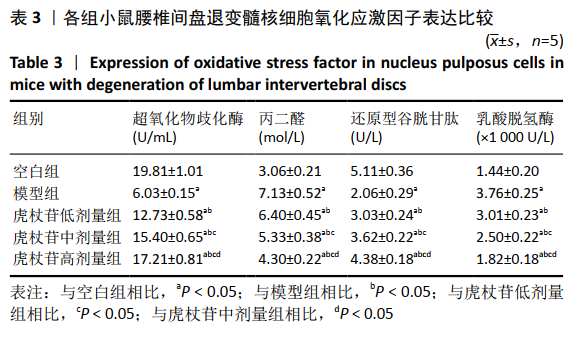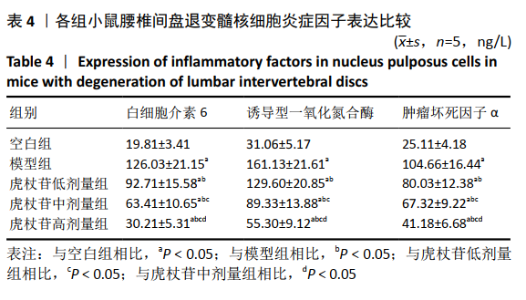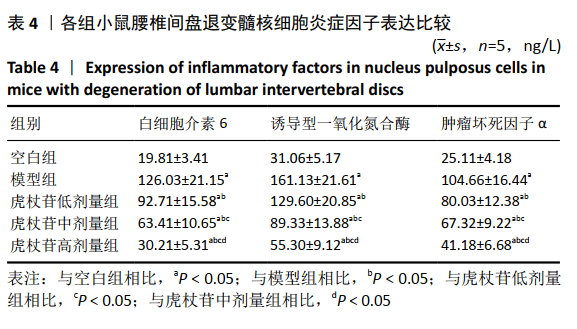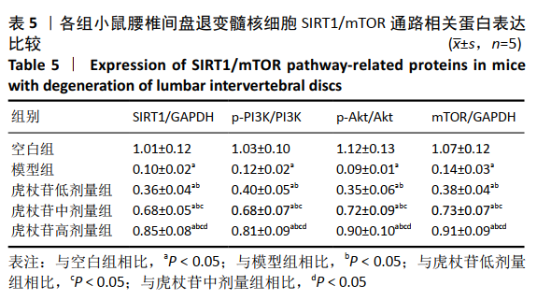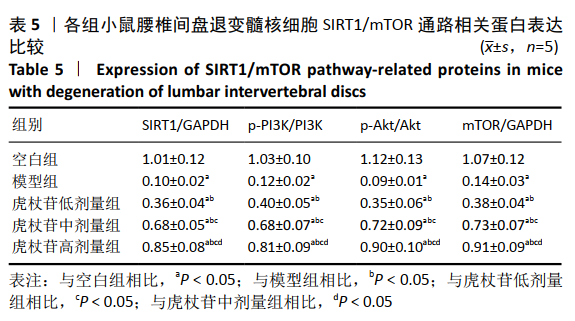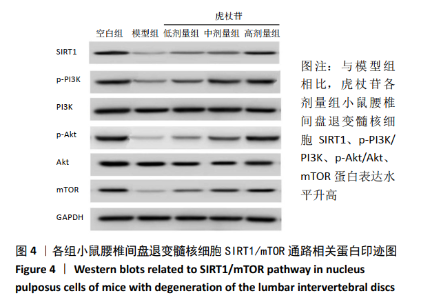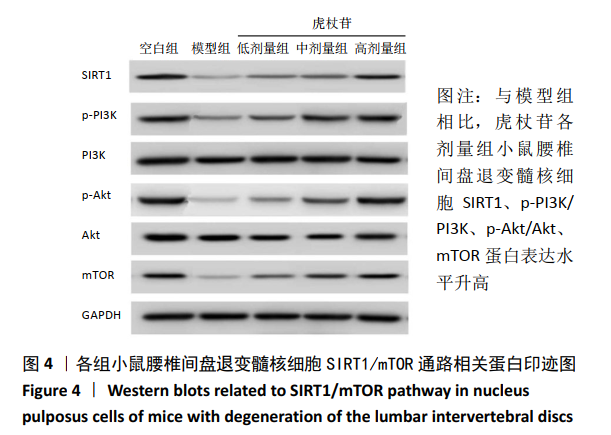Chinese Journal of Tissue Engineering Research ›› 2021, Vol. 25 ›› Issue (35): 5619-5625.doi: 10.12307/2021.290
Previous Articles Next Articles
Polydatin effects on apoptosis of nucleus pulposus cells and SIRT1/mTOR pathway in mice with lumbar disc degeneration
Zuo Bin, Xia Xiaofeng, Che Biao, Zou Kai, Tang Jiaguo
- Department of Orthopedics, General Hospital of the Yangtze River Shipping, Wuhan 430010, Hubei Province, China
-
Received:2020-11-24Revised:2020-12-31Accepted:2021-01-23Online:2021-12-18Published:2021-08-03 -
Contact:Xia Xiaofeng, Attending physician, Department of Orthopedics, General Hospital of the Yangtze River Shipping, Wuhan 430010, Hubei Province, China -
About author:Zuo Bin, Attending physician, Department of Orthopedics, General Hospital of the Yangtze River Shipping, Wuhan 430010, Hubei Province, China -
Supported by:the Joint Fund Project of Hubei Provincial Health Commission, No. WJ2019H388 (to TJG)
CLC Number:
Cite this article
Zuo Bin, Xia Xiaofeng, Che Biao, Zou Kai, Tang Jiaguo. Polydatin effects on apoptosis of nucleus pulposus cells and SIRT1/mTOR pathway in mice with lumbar disc degeneration[J]. Chinese Journal of Tissue Engineering Research, 2021, 25(35): 5619-5625.
share this article
Add to citation manager EndNote|Reference Manager|ProCite|BibTeX|RefWorks
| [1] PULICKAL T, BOOS J, KONIECZNY M, et al. MRI identifies biochemical alterations of intervertebral discs in patients with low back pain and radiculopathy. Eur Radiol. 2019;29(12):6443-6446. [2] WANG B, SHI Y, CHEN B, et al. No evidence of a correlation between lumbar spinal subtypes and intervertebral disc degeneration among asymptomatic middle-aged and aged patients. Exp Ther Med. 2020; 20(4):2993-3000. [3] GARCIA-JUST A, MIRÓ L, PÉREZ-BOSQUE A, et al. Dietary Spray-Dried Porcine Plasma Prevents Cognitive Decline in Senescent Mice and Reduces Neuroinflammation and Oxidative Stress. J Nutr. 2020; 150(2):303-311. [4] FERTAN E, RODRIGUES GJ, WHEELER RV, et al. Cognitive Decline, Cerebral-Spleen Tryptophan Metabolism, Oxidative Stress, Cytokine Production, and Regulation of the Txnip Gene in a Triple Transgenic Mouse Model of Alzheimer Disease. Am J Pathol. 2019;189(7): 1435-1450. [5] YANG M, PENG Y, LIU W, et al. Sirtuin 2 expression suppresses oxidative stress and senescence of nucleus pulposus cells through inhibition of the p53/p21 pathway. Biochem Biophys Res Commun. 2019;513(3):616-622. [6] XU WN, ZHENG HL, YANG RZ, et al. Mitochondrial NDUFA4L2 attenuates the apoptosis of nucleus pulposus cells induced by oxidative stress via the inhibition of mitophagy. Exp Mol Med. 2019;51(3):1-16. [7] 张新彧, 黄杨, 孙纪元, 等.虎杖苷对急性百草枯中毒大鼠肺损伤的干预研究[J]. 解放军医药杂志,2018,30(4):9-12. [8] GAO Y, CHEN T, LEI X, et al. Neuroprotective effects of polydatin against mitochondrial dependent apoptosis in the rat cerebral cortex following ischemia /reperfusion injury. Mol Med Rep. 2016;14(6):5481-5488. [9] 祝志强, 李佳, 孙晴, 等. 虎杖苷对急性脊髓损伤大鼠氧化应激反应和炎症反应影响[J].临床军医杂志,2018,46(4):435-438. [10] CHEN P, CHEN F, LEI J, et al. Activation of the miR-34a-Mediated SIRT1/mTOR Signaling Pathway by Urolithin A Attenuates D-Galactose-Induced Brain Aging in Mice. Neurotherapeutics. 2019;16(4):1269-1282. [11] CHEN J, HOU C, CHEN X, et al. Protective effect of cannabidiol on hydrogen peroxideinduced apoptosis, inflammation and oxidative stress in nucleus pulposus cells. Mol Med Rep. 2016;14(3):2321-2327. [12] LU K, LI HY, YANG K, et al. Exosomes as potential alternatives to stem cell therapy for intervertebral disc degeneration: in-vitro study on exosomes in interaction of nucleus pulposus cells and bone marrow mesenchymal stem cells. Stem Cell Res Ther. 2017;8(1):108. [13] 李卫玲, 茹琴, 林款, 等. 虎杖苷对四氧嘧啶诱导的大鼠胰岛细胞损伤的保护作用[J].食品工业科技,2020,41(3):315-320. [14] 刘洋, 贾宇涛, 孙天威, 等. 甲基莲心碱对腰椎间盘退变大鼠的影响[J]. 中国临床药理学杂志,2019,35(15):1648-1651. [15] 史锐, 朱振军, 杨永波. 牛磺酸调节白介素水平对椎间盘退变大鼠模型髓核细胞凋亡、炎症和氧化应激的保护作用[J]. 中国免疫学杂志,2020,36(9):1097-1102. [16] VIJAYARATHNA S, OON CE, CHEN Y, et al. Polyalthia longifolia Methanolic Leaf Extracts (PLME) induce apoptosis, cell cycle arrest and mitochondrial potential depolarization by possibly modulating the redox status in hela cells. Biomed Pharmacother. 2017;89(1):499-514. [17] 陈江, 肖辉灯, 孙旗, 等.人椎间盘髓核细胞增殖活性与益肾活血通络方的干预调控[J]. 中国组织工程研究,2020,24(8):1200-1206. [18] JIN H, WANG Q, WU J, et al. Baicalein Inhibits the IL-1β-Induced Inflammatory Response in Nucleus Pulposus Cells and Attenuates Disc Degeneration In vivo. Inflammation. 2019;42(3):1032-1044. [19] HUANG Y, JIANG T, CHEN J, et al. Effects of kartogenin on the attenuated nucleus pulposus cell degeneration of intervertebral discs induced by interleukin-1β and tumor necrosis factor-α. Int J Mol Med. 2018;41(2):749-756. [20] ZHU HAI, CHEN G, WANG Y, et al. Dimethyl fumarate protects nucleus pulposus cells from inflammation and oxidative stress and delays the intervertebral disc degeneration. Exp Ther Med. 2020;20(6):269-269. [21] 刘志刚, 郭庆功, 陈景涛. 刺山柑总生物碱干预椎间盘退变模型大鼠髓核细胞的增殖与凋亡[J]. 中国组织工程研究,2021,25(11): 1699-1704. [22] SU X, LIU B, GONG F, et al. Isofraxidin attenuates IL-1β-induced inflammatory response in human nucleus pulposus cells. J Cell Biochem. 2019;120(8):13302-13309. [23] WANG K, CHEN T, YING X, et al. Ligustilide alleviated IL-1β induced apoptosis and extracellular matrix degradation of nucleus pulposus cells and attenuates intervertebral disc degeneration in vivo. Int Immunopharmacol. 2019;69(1):398-407. [24] 张强, 刘萍, 秦飞,等. 香叶木素通过抑制髓核细胞凋亡和炎症反应缓解椎间盘退变大鼠神经根性疼痛[J]. 免疫学杂志,2020, 36(12):1046-1052. [25] WANG X, WANG B, ZOU M, et al. CircSEMA4B targets miR-431 modulating IL-1β-induced degradative changes in nucleus pulposus cells in intervertebral disc degeneration via Wnt pathway. Biochim Biophys Acta Mol Basis Dis. 2018;1864(11):3754-3768. [26] WANG J, NISAR M, HUANG C, et al. Small molecule natural compound agonist of SIRT3 as a therapeutic target for the treatment of intervertebral disc degeneration. Exp Mol Med. 2018;50(11):1-14. [27] ZHANG Q, LI J, LI Y, et al. Bmi deficiency causes oxidative stress and intervertebral disc degeneration which can be alleviated by antioxidant treatment. J Cell Mol Med. 2020;24(16):8950-8961. [28] SUN Z, LIU B, LUO Z. The Immune Privilege of the Intervertebral Disc: Implications for Intervertebral Disc Degeneration Treatment. Int J Med Sci. 2020;17(5):685-692. [29] 滕金艳,丁德光,黄国付,等. 补肾壮腰膏联合补肾祛瘀针法治疗腰椎间盘突出症急性发作的疗效观察[J].中华全科医学,2020, 18(4):654-656+685. [30] 刘祺, 杨舟, 朱青安. 氧化应激与椎间盘退变的研究进展[J]. 中国临床解剖学杂志,2020,38(3):363-366. [31] CHEN ZB, YU YB, WA QB, et al. The role of quinazoline in ameliorating intervertebral disc degeneration by inhibiting oxidative stress and anti-inflammation via NF-κB/MAPKs signaling pathway. Eur Rev Med Pharmacol Sci. 2020;24(4):2077-2086. [32] 郝洁, 王淑君, 梁艳,等. 虎杖苷调节糖脂代谢及心肾保护作用研究进展[J].中药药理与临床,2016,32(3):201-204. [33] 王曌华, 张永, 裴敬仲. 虎杖苷对严重烧伤小鼠早期肠损伤及SIRT1/NF-κB通路的影响[J]. 中国免疫学杂志, 2020, 36(5):566-570. [34] QIAO H, CHEN H, DONG Y, et al. Polydatin attenuates H2O2-induced oxidative stress via PKC pathway. Oxid Med Cell Longev. 2016;39(3): 436-449. [35] RAMÍREZ A, HERNÁNDEZ M, SUÁREZ-SÁNCHEZ R, et al. Type 2 diabetes–associated polymorphisms correlate with SIRT1 and TGF‐β1 gene expression. Ann Hum Genet. 2020;84(2):185-194. [36] SUN W, LI Y, WEI S. miR-4262 regulates chondrocyte viability, apoptosis, autophagy by targeting SIRT1 and activating PI3K/AKT/mTOR signaling pathway in rats with osteoarthritis. Exp Ther Med. 2018;15(1): 1119-1128. [37] XU M, FENG M, PENG H, et al. Epigenetic regulation of chondrocyte hypertrophy and apoptosis through Sirt1/P53/P21 pathway in surgery-induced osteoarthritis. Biochem Biophys Res Commun. 2020; 528(1):179-185. [38] 翟铁,郝凤杰,田雪品,等.过表达SIRT1基因通过PI3K/AKT信号通路抑制高糖刺激心肌H9c2细胞凋亡和活性氧水平[J].中国病理生理杂志,2019,35(5):889-893. [39] ZHU Q, ZHU G, XU W, et al. Bupivacaine inhibits angiogenesis through oxidative stress‐dependent inhibition of Akt/mTOR and activation of AMPK. Fundam Clin Pharmacol. 2020;34(5):581-590. [40] SUN Y, DAI S, TAO J, et al. Taurine suppresses ROS-dependent autophagy via activating Akt/mTOR signaling pathway in calcium oxalate crystals-induced renal tubular epithelial cell injury. Aging. 2020;12(17):17353-17366 [41] 兰晶, 潘敬芳. 姜黄素对脑缺血再灌注损伤大鼠PI3K/AKT/mTOR的影响[J].重庆医学,2017,46(1):36-39. |
| [1] | Liu Zhichao, Zhang Fan, Sun Qi, Kang Xiaole, Yuan Qiaomei, Liu Genzhe, Chen Jiang. Morphology and activity of human nucleus pulposus cells under different hydrostatic pressures [J]. Chinese Journal of Tissue Engineering Research, 2021, 25(8): 1172-1176. |
| [2] | Cheng Ning, Zhang Zhizhong. Regulatory effects of LncRNA MEG3 on the proliferation and apoptosis of nucleus pulposus cells in rat intervertebral disc [J]. Chinese Journal of Tissue Engineering Research, 2021, 25(26): 4106-4111. |
| [3] | Jiang Lihong, Wu Xiaofeng, Ouyang Lin, Luo Aifang, Huang Li. Computer aided diagnosis of lumbar disc degeneration based on metabolomics [J]. Chinese Journal of Tissue Engineering Research, 2021, 25(24): 3796-3803. |
| [4] | Fu Yuanfei, He Shenghua, Lai Juyi, Sun Zhitao, Feng Hualong, Lan Zhiming . Pheretima extract ameliorates nucleus pulposus cell degeneration in the intervertebral disc by inhibiting nuclear factor-kappa B pathway [J]. Chinese Journal of Tissue Engineering Research, 2021, 25(2): 264-268. |
| [5] | Zhang Kai, Zhang Xiaobo, Shi Jintao, Wang Keping, Zhou Haiyu. Mesenchymal stem cells for treatment of intervertebral disc degeneration: a bibliometric and visualization analysis based on Web of Science database [J]. Chinese Journal of Tissue Engineering Research, 2021, 25(19): 3031-3038. |
| [6] | He Shenghua, Fu Yuanfei, Lan Zhiming, Sun Zhitao, Lai Juyi, Feng Hualong, Guo Zibin, Li Gai . Yaotu Granule deals with the proliferation and apoptosis of nucleus pulposus cells via regulating the expression of microRNA-221 [J]. Chinese Journal of Tissue Engineering Research, 2021, 25(14): 2177-2182. |
| [7] | Liu Zhigang, Guo Qinggong, Chen Jingtao. Effect of Capparis spinosa total alkaloid on proliferation and apoptosis of nucleus pulposus cells in an intervertebral disc degeneration rat model [J]. Chinese Journal of Tissue Engineering Research, 2021, 25(11): 1699-1704. |
| [8] | Chen Jiang, Xiao Huideng, Sun Qi, Zhang Fan, Zhu Yonggang, Liu Zhichao, Guo Feiyu, Liu Genzhe. Proliferative activity of nucleus pulposus cells in human intervertebral disc and intervention with Yishen Huoxue Tongluo Recipe [J]. Chinese Journal of Tissue Engineering Research, 2020, 24(8): 1200-1206. |
| [9] | Yin Xunlu, Zhu Liguo, Feng Minshan, Yu Jie, Zhan Jiawen, Liang Long, Han Tao. Effect of continuous loading pressure on apoptosis and Wnt/beta-catenin signaling pathway in nucleus pulposus cells [J]. Chinese Journal of Tissue Engineering Research, 2020, 24(26): 4125-4128. |
| [10] | Feng Yang, Yan Xu, Wang Yongkui, Yang Tengyue, Shang Lijie, Zhang Chunlin. Relationship between degenerative lumbar disc disease and peripheral blood lymphocyte subsets [J]. Chinese Journal of Tissue Engineering Research, 2020, 24(17): 2630-2635. |
| [11] | Xie Mingzhong, Li Sen, Zhu Kai, Jiang Huacai, Qi Lisheng. Expression of cyclic RNA plasmacytoma variant translocation 1 in senescence of nucleus pulposus cells and its regulation mechanism [J]. Chinese Journal of Tissue Engineering Research, 2020, 24(17): 2718-2723. |
| [12] | Liang Weidong, Ren Zhouliang, Sheng Jun, Cao Rui, Sheng Weibin. Interleukin-1beta, interleukin-6 and tumor necrosis factor-alpha inhibit expression of type II collagen in nucleus pulposus cells [J]. Chinese Journal of Tissue Engineering Research, 2019, 23(21): 3410-3417. |
| [13] | Xu Qing, Fang Haolin, Liu Yang, Zhang Cunxin, Tian Baofang. Proanthocyanidins inhibit high glucose-induced apoptosis in nucleus pulposus cells in a rabbit [J]. Chinese Journal of Tissue Engineering Research, 2019, 23(21): 3426-3431. |
| [14] | Chen Tao, Li Guan-bao, Liang Ke-you, Jia Shi-qing. Correlation between lumbar disc degeneration and COL9A2 gene single nucleotide polymorphisms [J]. Chinese Journal of Tissue Engineering Research, 2013, 17(9): 1695-1702. |
| [15] | Wang Hai, Huang Bo, Zhou Yue, Wang Jian, Li Chang-qing. Biological characteristics of nucleus pulposus cells from human degenerative intervertebral disc using the improved simple method [J]. Chinese Journal of Tissue Engineering Research, 2013, 17(28): 5139-5144. |
| Viewed | ||||||
|
Full text |
|
|||||
|
Abstract |
|
|||||


